Photography by Rafael Tongol
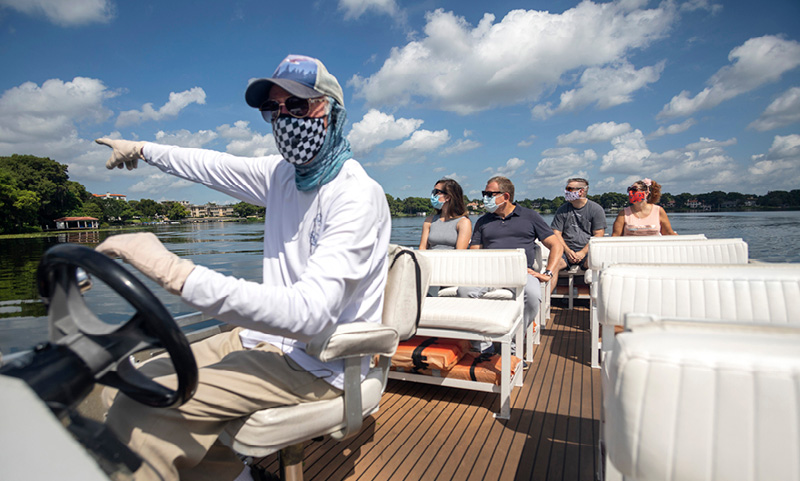
In high summer, the best time to take the Winter Park Scenic Boat Tour is morning, on the first boat out at 10 a.m. Then, the lake is still glassy and the air fresh before the sultry afternoon doldrums descend.
Such was the idyllic tableau the Monday morning in mid-August when I arrived at the venerable tour boathouse on the southwest shore of Lake Osceola, a 10-minute walk from downtown. I’d come to enjoy the excursion in preparation for a story on what is said to be the longest continuously operated tourist attraction in Florida.
“I’m not the original driver,” quips Tom Smith as I board the pontoon boat. Smith, 67, is among the most senior of the boat tour’s nine pilots, more affectionately called “skippers” a la the bumbling, blustery Skipper on TV’s Gilligan’s Island. (Played by Alan Hale Jr., for all you trivia buffs.)
Smith figures that in 10 years, he has conducted close to 13,000 tours of Winter Park’s lakes and canals. That means he’s guided his craft some 156,000 miles — all the while delivering good-natured banter (and more than a few corny jokes).
He talks about the city’s history and calls upon a storehouse of factoids about the flora and fauna that are at times so close to the boat that passengers can reach out and touch swaying palms, grand cypress trees, lush ferns and riots of flourishing subtropical flowers.
The Scenic Boat Tour, which was closed for most of March through May because of COVID-19, is back, once again wending its way along three of the city’s six canal-connected lakes (Osceola, Virginia and Maitland) and offering peeks into the manicured backyards of opulent homes, the residents of which mostly offer friendly waves.
The driver at the helm of the first “Venice of America” tour on January 1, 1938, was the man who started it, Walt C. Meloon — better known as “W.C.” — a New England transplant and entrepreneur who would later found a boating empire.
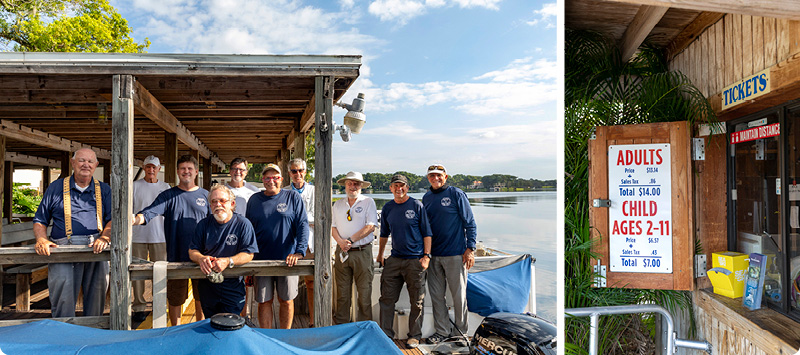
A vintage photo of the maiden voyage shows a grinning W.C. wearing what appears to be a yacht captain’s cap. Seated behind him in the long wooden boat are 25 city officials, businessmen and their spouses who have unwittingly (and literally) participated in the launch of what would become arguably the city’s most iconic business.
Eighty-two years and a pandemic later, the scene was starkly different for my tour. The vessel — one of a fleet of six — was now an aluminum pontoon boat with a seating capacity of 18, reduced to nine by social distancing. (The drivers wear masks and the boats are disinfected after each outing.) And on this Monday morning, I was Skipper Tom’s only passenger.
In a normal year B.C. — before COVID — the tour attracted about 120 riders per day, or between 40,000 to 50,000 riders per year. Despite wars and hurricanes, tours had been held almost every day (except Christmas) since the administration of Franklin D. Roosevelt. There had been no prolonged shutdowns until the virus arrived.
“We’re now doing about 20 percent of our usual business,” says owner Ron Hightower. “This time of year, we depend mostly on international travelers. People come from around the world. One time I put up a map with pins, and after a month or two I couldn’t find anyplace people weren’t from. Obviously, right now no one is flying.”
The federal Paycheck Protection Program helped pay the skippers and keep the business, well, afloat. “It’s been challenging,” Hightower says.
It was indeed challenging — to say nothing of a bit awkward — for Smith to have an audience of only one to hear his entertaining shtick. It wasn’t unlike Steven Colbert or Jimmy Fallon doing jokes for empty theaters with only the band present to offer titters and guffaws.
I was the band on this trip. I told Smith to pretend there were other passengers and to do his normal routine. “OK,” he said. “If you like the tour, I’m Tom. If not, I’m Robert.” (Cue the rim shot.)
The pontoon chugged away from the dock. Smith immediately busted through the fourth wall, turning and explaining: “By now I’ve usually told everyone how much better-looking I am in a mask.”
FROM TOUR GUIDE TO TYCOON
God created the breathtaking Winter Park lakes, as well as the plant and animal life that these ecosystems support. Man, though, created the enchanting canals. Well, sort of. Swampy connectors apparently already existed but were basically impassable — and therefore useless for transportation or commerce until they were widened and bolstered.
The City of Winter Park, which was originally envisioned as a New England-themed resort town, began its life as a rarified tourist attraction in the late 1880s. It just took an ambitious visionary like W.C. Meloon to make the elevated enclave more accessible to those who weren’t Northern industrialists occupying its so-called “cottages.”
“W.C. was quite an entrepreneur — building, making, creating,” says his grandson Walt Meloon, one of many Walts in the lineage. “He had an inventor’s mind. He built a boat with a Model T engine and an airplane propeller. It was really an airboat. He did automotive repairs and had one of the first motels — or trail lodges — in New Hampshire.”
Then his New Hampshire garage burned down, and W.C. — among countless others — heard that exotic Florida was the land of milk and honey. “There was a land boom going on and he decided to move to Florida to become a land baron,” says Walt Meloon, a Belle Isle resident.
W.C., his wife and three sons moved to Orlando in 1924 from their farm on the Maine-New Hampshire border. The boom, however, went bust, ruining many who had journeyed to the Sunshine State to make their fortunes.
But W.C. wasn’t easily deterred. “He looked around and saw a lot of water and all those lakes,” says his grandson. “So, he decided he needed to build boats.” Declaring that he intended to build watercraft “for the glory of God,” W.C. called his new venture in Pine Castle on South Orange Avenue the Florida Variety Boat Company.
The story goes he changed the name to Correct Craft in 1936 after hearing a radio ad touting shoes with “the correct heel for your feet.” He liked the idea of pitching his boats as “the correct craft for you.” The fledgling company originally built and sold powerboats, race boats and even sailboats.
But W.C. didn’t confine himself to water vessels. The company dredged sand from lakes for beaches. It won a contract to build a dam and waterslides for Sanlando Springs, a recreational area between Orlando and Sanford. It installed cypress-wood walls (subsequently replaced by concrete) to shore up the deteriorating banks of the Winter Park canals. It even built boathouses.
In addition to becoming a leader in recreational watercraft, Correct Craft was contracted by the government during World War II to build pontoon-like boats that served as bridges to carry troops and armaments across rivers. In 2008, when the Meloons sold the last of their stock in the company, Correct Craft was the oldest family-owned boat maker in America.
For all his wider renown, W.C.’s best-loved legacy remains the Winter Park Scenic Boat Tour. This, too, was an idea he brought with him from New England, where his boating fixation was born. Says Walt Meloon: “He and his friends would ride around and find a lake where they could put a boat in and tacked up a sign: ‘Rides 45 cents.’”
Yet, W.C.’s local venture might well have ended up the Lake Conway Scenic Boat Tour. The family, for a time in the 1930s, offered rides on the Conway Chain of Lakes (25 cents for adults, 10 cents for kids), recalled the late Ralph Meloon, one-time company president, in a 2014 interview. So why did W.C. plant his dream 14 miles away in Winter Park instead of just up the road from Correct Craft on South Orange Avenue?
“About that time, there was more development of big homes and more wealth in a concentrated area, which was Winter Park,” says Walt Meloon. “It was much more attractive. And the canals were the clincher — the pure, raw beauty. The Conway lakes didn’t have anything like that.”
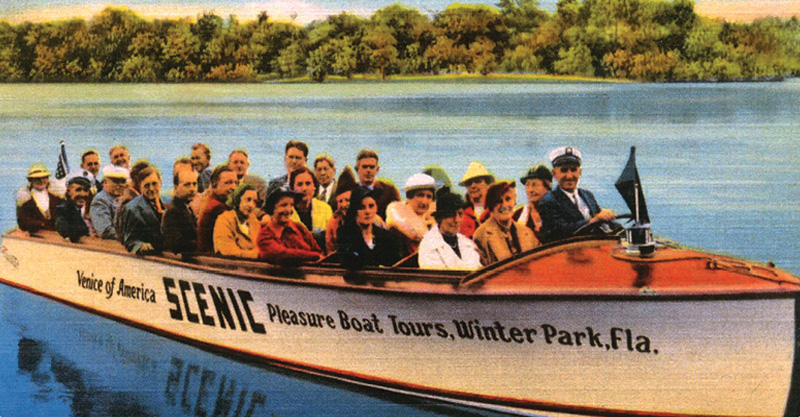
DO THE STORIES HOLD WATER?
“Duck your head!” Smith shouts as we pass under a low bridge on the Fern Canal. “This is the point where passengers usually decide to get up and introduce themselves.” Noting imperfections along the way, Smith says: “Lumberjacks did this. Looks like they had some cocktails before digging.”
Sobriety aside, it seems to be true that lumber companies widened the clogged and narrow waterways in the 19th century to float harvested logs from nearby forests to sawmills. Later, between 1935 and 1938, private and public funds paid for rebuilding the rotting cypress barrier walls to make the canals more boater friendly. From 1976 to 1978, the City of Winter Park and the Florida Boating Improvement Program, a division of the Department of Environmental Protection, undertook another rehabilitation project.
The results, as anyone who has ever taken the boat tour can attest, are stunning. Enveloped by a canopy of ferns, ancient oaks, banana plants, bamboo, cypress and palm trees, we glide past briefly glimpsed homes on either side and into the open water of Lake Virginia.
Smith points to the Rollins College campus on the northern shore, where the school’s ski and rowing teams practice on the lake. “People ask about the thing that looks like the roof of a sunken house,” Smith says. “It’s the ski jump.”
Especially in his Skipper Tom persona, Smith can be gently mischievous with visitors from distant places, such as Maine. Bobbing in the water near the ski jump are colorful buoys for a slalom course. When a passenger from the Pine Tree State wondered if they were lobster traps, Smith didn’t skip a beat: “Yes, fresh-water lobsters.”
The geography and vegetation encountered along the canals are a mystery to many passengers. “People from places like Sweden and New York freak out when they see bananas,” says Smith as we meander through the Venetian Canal to Lake Maitland. “They’ve never seen bananas growing.”
Some even point to one of the gaudy mansions in the distance and ask if Donald Trump lives there. No, Smith patiently explains, he lives in Mar-a-Lago, some 200 miles away.
There are the inevitable questions about alligators, but according to Smith, none are ever seen along the route. “We don’t have them anymore,” he says. In fact, about 150 of the frightening reptiles were taken from the Winter Park Chain of Lakes and repatriated to Seminole County’s more primitive Lake Jesup in the late 1980s.
Smith runs through a litany of places and stories familiar to locals. How the historic Capen-Showalter House was cut in two and transported on barges across Lake Osceola to the Albin Polasek Museum & Sculpture Gardens. “Fred and Ginger dancing across the lake,” as he describes the project.
Then there’s the Brewer House, a 21-room mansion built in 1889 by industrialist Edward Hill Brewer. At the insistence of Brewer’s homesick wife, Edna, it was designed to be an exact replica of the family’s estate in New York.
Sometimes, though, the stories should be taken with a proverbial grain of salt. Smith points out a red-brick house that he says was built (and occupied) by the indulgent parents of Fred Rogers (Rollins College, Class of 1951) so that the music composition major could have a proper piano on which to practice. “Well, that’s the story we tell,” Smith says with a grin.
To be clear, the man who would become known to the world as Mister Rogers through the PBS series Mister Rogers’ Neighborhood, did retain a lifelong connection to Winter Park. He rented a house near Osceola Avenue for seasonal visits with his wife, Joanne, who also graduated from Rollins. But his parents, James and Nancy Rogers, lived in Latrobe, Pennsylvania.
This is, of course, quibbling. Drivers are not allowed to identify current residents — famous or not — of lake homes. But they’re free to name-drop past residents. “There’s the house built by the founder of Walgreens,” Smith points out. “As soon as it was built, CVS put one up next door even bigger.”
Tom Hanks never lived in the so-called “Tom Hanks House,” Smith notes of a Venetian-style home that can be seen from Lake Osceola. But it was, he says, used in filming Hanks’ HBO series From the Earth to the Moon, getting about 30 seconds of airtime as the home of an astronaut.
He later points out the sprawling home of former Orlando Magic star Horace Grant, who turned the ballroom into a basketball court. And over there is the historic Alabama Hotel (now condominiums) whose guests included the likes of Margaret Mitchell, H.G. Wells and Sinclair Lewis.
“And that’s my house to the right,” says Smith, ever the joker.
Along the way, across the three lakes and two canals, Smith is hailed by friends in boathouses or kayaks. “Hey, Bobby, come ahead!” he shouts, offering right-of-way to a kayak coming at us through the narrow canal. “You’re good to go, guys!” he signals another, before yet again spying a familiar figure and calling out: “How ya doing, sweetie!”
Smith turns to me and says: “I know way too many people here.”
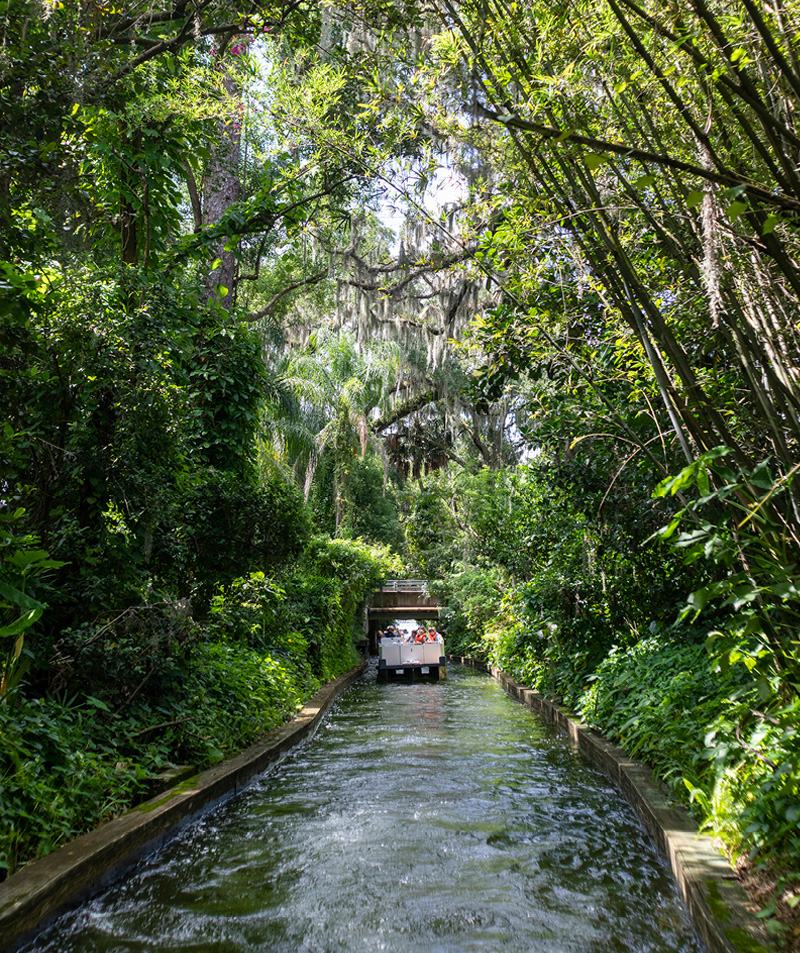
‘IT JUST GIVES YOU A SPECIAL FEELING’
The boat tour has changed hands several times over the decades. Wanda Salerno, a legendary Winter Park booster, and her husband, Frank, bought it in 1981 and ran it for 14 years, pumping up its popularity with aggressive advertising on International Drive.
In 1995, Hightower and his granddad Stanford Smith — a boat tour driver and manager since 1971 — jumped at a ticket to ride. “The Salernos were interested in selling and we were interested in carrying on the tradition,” Hightower says. “I grew up in Winter Park and worked down here in my early teens, gassing up boats and that sort of thing.”
For Smith, who worked into his late 90s and died in 2013 at 100, the boat tour was a second career after retiring from the banking business at 58. His grandson, however, vows that there’ll be no second act for him. “This is my career,” says Hightower, a UCF grad with a degree in business administration.
Winter Park’s “Venice of America” isn’t the only “Venice of America” and maybe not the first — even in Florida. In the 1920s, mangrove swamps around Fort Lauderdale were dredged to create a network of waterways including “finger island” subdivisions. The city adopted the “Venice of America” moniker, but it’s not clear if that happened before W.C. went into the boat tour business.
Both cities lose out historically to a beachfront theme park/resort with canals near Los Angeles that opened in 1905 with the name “Venice of America.” The area later was absorbed by Los Angeles and became just plain Venice. “I only know we used [the slogan] from the very beginning in 1938,” Hightower says. “I never heard of the other.”
Winter Park’s “Venice of America” was fortuitously well-positioned to hang on at a time when many small businesses succumbed to the pandemic economy. “We’ve worked hard to keep prices affordable for families,” Hightower says.
Ticket prices are $14 for adults, $7 for children (under age 2 ride free). An undated brochure from the early days shows the price of a ticket at $1.50 for adults and 75 cents for kids. Adjusted for inflation, that $1.50 ticket today would be $27. And parking is free. So the experience remains a notable and refreshingly homespun bargain.
In a city blessed with an embarrassment of tourist-attracting riches, the boat tour is tops, says Camellia Gurley, concierge at the Winter Park Chamber of Commerce. “It’s the No. 1 thing we promote,” she says. “It’s so loved. I don’t think anything compares to it. If someone from out of town comes to see me, I say, ‘Let’s do this!’ It just gives you a special feeling.”
On the still placid waters of Lake Osceola, Skipper Tom concludes his narrative and guides the pontoon back to the dock after the hourlong tour, which, once again, has miraculously averted the fate of Gilligan’s marooned S.S. Minnow.
“The canals are so unique that even if I didn’t say a word it would be a great trip,” he says. But not quite as great. And let the record show that Skipper Tom is actually better looking without a mask.
SKIPPER SPOTLIGHTS
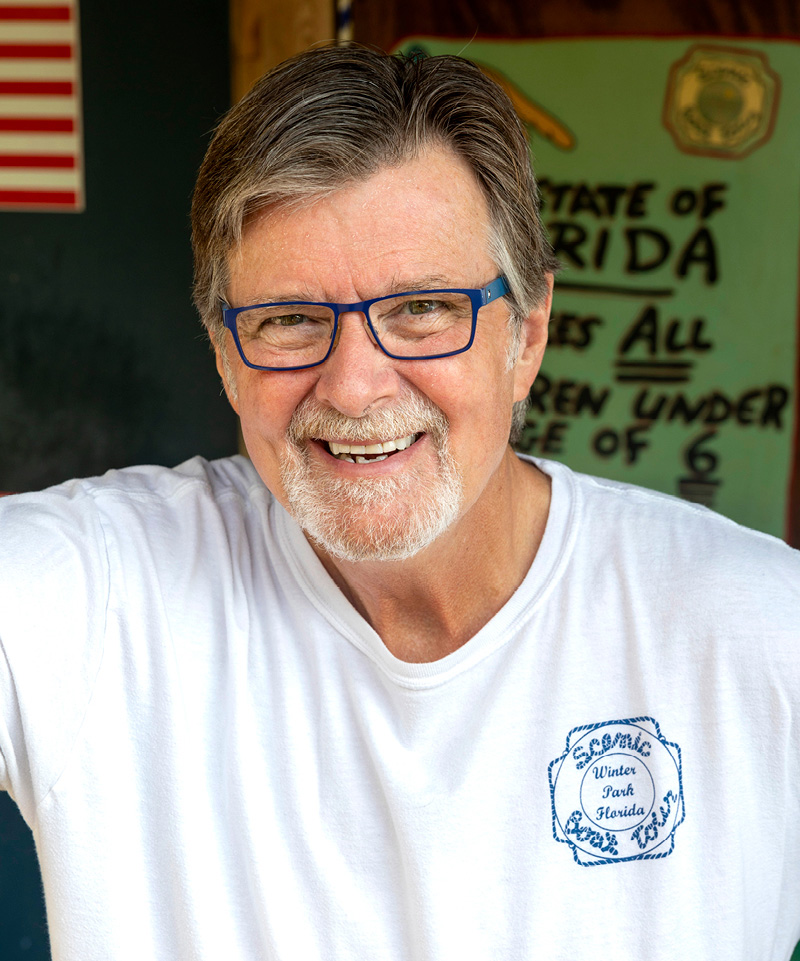
Fred Austin
Former drummer and actor
Fred Austin, 70, was a real character even before he was paid to be one. He grew up in Yonkers, just north of New York City, with dreams of pursuing a career in theater. Instead, he says, “I pursued drumming for 25 years, playing in show bands.” But the acting bug beckoned and in 1992 Austin moved to Central Florida, where he joined Universal Orlando playing a series of real characters — including Merlin, Dudley Do-Right, Harry Henderson and Frankenstein’s monster. His final role was Wandkeeper at Ollivander’s Wand Shop in the Wizarding World of Harry Potter. Later a friend mentioned the Scenic Boat Tour, and Austin was intrigued. “I felt it was a good fit for me, especially with my mouth,” he says. “I enjoyed comedic acting, but I really wanted to be a stand-up comedian.” And now, that’s pretty much what he is (though standing up is an option). What did a kid from Yonkers know about boating? “I’ve been familiar with boating all my life,” Austin says. “I loved boats so much that I made sure I had friends who had boats.” Of course, during the tour Austin dispenses more than jokes. He’s there to inform as well as entertain. “I try to be spontaneous. If I see something in a boat going by that amuses me, I’ll say something,” he says. “But I try not to make it ‘The Fred Austin Show.’ It’s not about me, it’s about the boat tour.” Austin still draws on all those years portraying theme park characters. “We (drivers) all have funny lines that are kind of our routines,” he adds. “I learned that in the theme park, where you have a new audience for six shows a day. It’s never boring — I never get tired of doing this.”
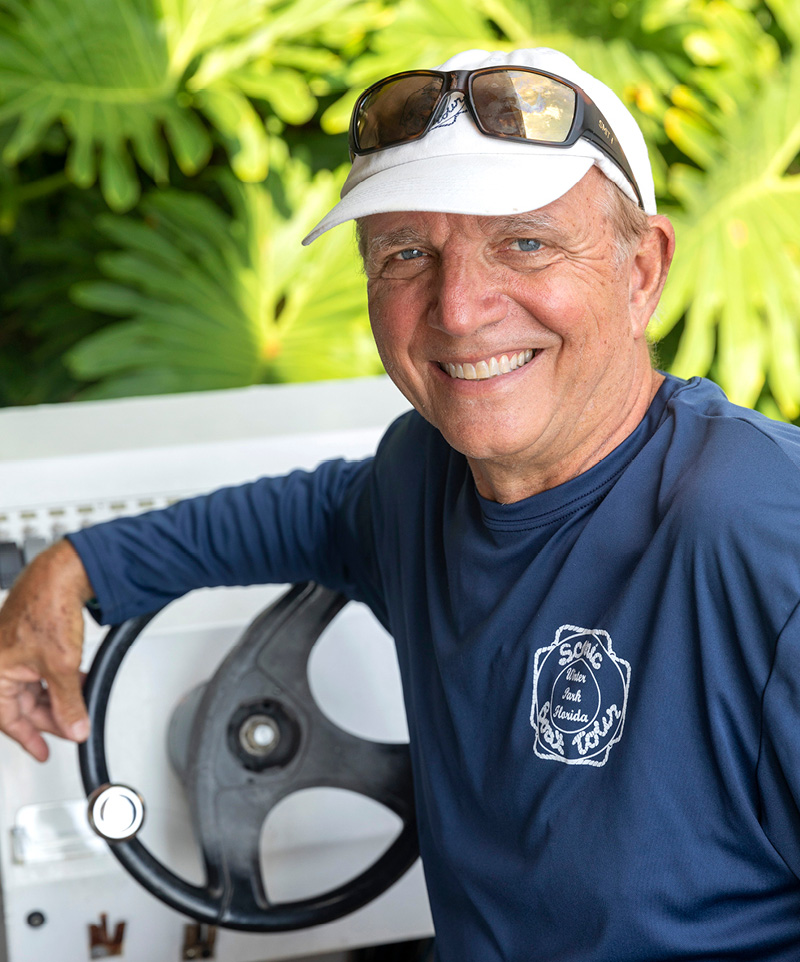
Tom Smith
Former restaurateur, social worker and bartender
After graduating from the University of Florida in 1974, at age 21, Tom Smith opened a Domino’s franchise. “I lost my ass on that, but fell in love with Winter Park,” he says. “I’ve been in the same house on the west side of Lake Virginia since 1975. I’ve had a boat every day since I bought the house. The boat tour was one of the first things I did when I moved here, and it convinced me what a cool place this is.” It sounds like the gregarious Smith and the Scenic Boat Tour were made for one another — and perhaps they were. But first there were several landlubber careers: social worker, owner and manager of bars and restaurants, and a 21-year stint tending bar at Apopka’s legendary Townsend’s Fish House and Tavern, which closed in 2000. “I felt I did 10 times more social work tending bar,” says Smith, 67, laughing. It was, however, good basic training for his future gig as boat tour guide, where people skills are paramount. So were the chatty and informative walking excursions that he conducted for Winter Park City Tours. “It was short lived but made me learn as much as I could about the history of Winter Park,” he says. With 10 years and more than 10,000 trips under his belt, Smith is today one of the tour’s senior skippers. “I know an awful lot of people in Winter Park,” he says. “I probably have 1,000 regulars.” His presentation of “fun, facts and humor” obviously has worn well. “My whole goal,” he says, “is to give people a one-hour vacation.”
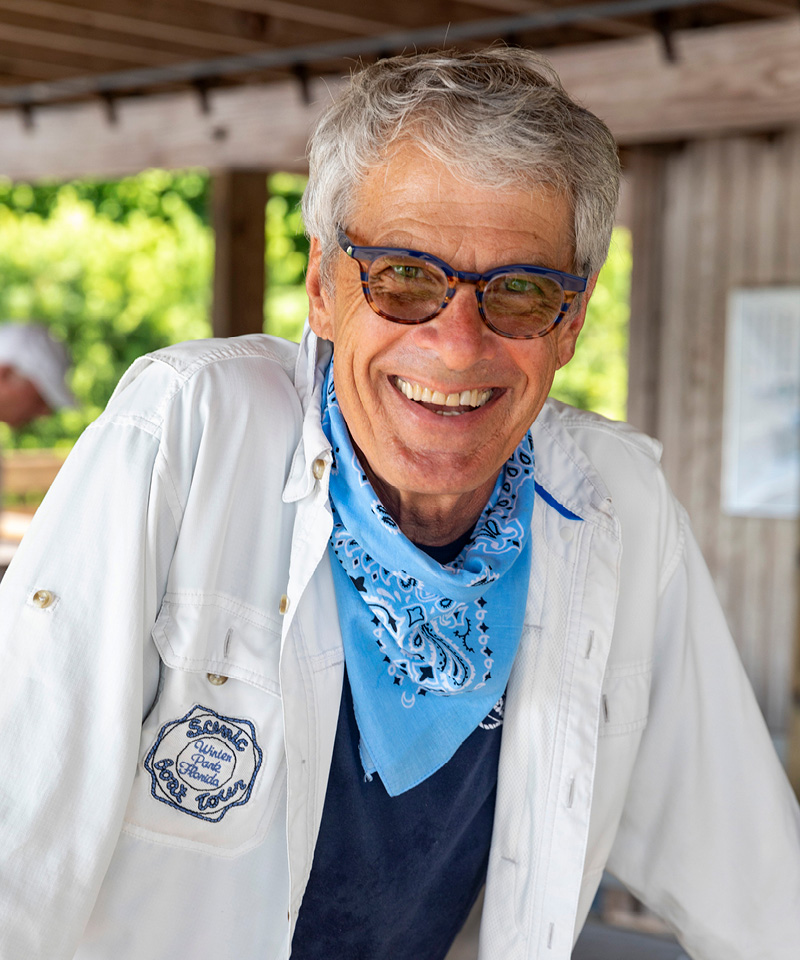
David Wittman
Former TV news anchor
In a five-decade career highlighted by professional pinnacles, David Wittman, 70, was the lead anchor for major-market TV stations in Detroit, Boston, Cleveland and Orlando, where he manned the news desk at WKMG-Channel 6 for a decade and fell in love with Winter Park. But, as it happened, Wittman didn’t pursue his true calling until recently. Now, however, the erstwhile broadcaster — who’s still recognized by longtime locals — proudly describes his profession on LinkedIn as simply: “Tour guide at the Winter Park Scenic Boat Tour.” Notes Wittman: “I think I always had it mind. I threatened Ron [Hightower, owner] that when I got out of the TV game, I was going to work for him or buy him out.” After leaving his final anchor gig in Cleveland, Wittman returned to Winter Park in 2018 and landed a job in the tour boat ticket office, “selling Cokes, cleaning toilets and emptying the trash. Eventually Ron said, ‘You want to drive?’ I said, ‘Yeah, I want to do that.’” Even before leaving Cleveland, Wittman and his wife had bought a condo on the Fern Canal, a leg of the tour. Ever the newsgatherer, he prepared for his stint as a driver by reading every book available about Winter Park history and spending countless hours combing through the archives and special collections area at Rollins College, where he uncovered fascinating tidbits to share with ticket buyers. The theme of Wittman’s tour narration: “The Secrets of Winter Park.” A typical nugget: “After Hurricane Donna in 1960, there was a push to widen the canals to a 100 feet because there was flooding. Thankfully, that did not survive a vote in local government. Just imagine how that would have changed things.”

